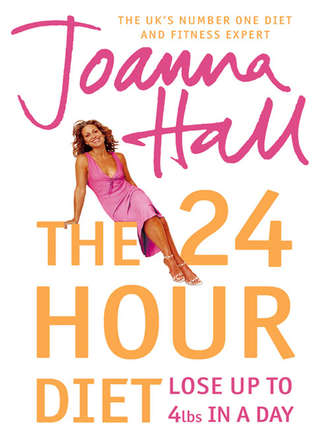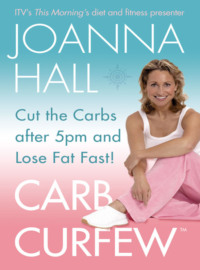
Полная версия
The 24 Hour Diet: Lose up to 4lbs in a Day
GET MOTIVATED!
To apply the rules successfully you need to be motivated to make a change. The rules can’t just take care of themselves; you do need to be prepared to put in a little effort. But in each of the 10 specially designed weight-loss plans in this section I’ve made it really simple for you to apply the rules highly effectively. All you have to do is introduce the rules one at a time. You’ll be losing weight and boosting your health while taking small, effective steps to achieving that weight loss and keeping it off.
This approach – setting a specific habit to groove, telling you why each rule will be beneficial, and offering you a support system to help reinforce the new behaviour – has been shown to be one of the most successful approaches. So when you start any of the weight-loss plans you can feel confident you are following a tried-and-tested method designed for you to succeed.
UNDERSTANDING HABITS
Before we begin, we need to understand a little about habits: what they are, how they are formed and how we learn new behaviours. This involves looking at how our brains work.
WEIGHTY HABITS
Like it or not we all have habits, little things we do on a regular basis. In terms of our health and weight, some of these may be positive and others not so positive. If you’re going to make an impact on your weight loss and improve your health, there are some new habits you’ll need to develop and groove and others you may need to ditch.
WHAT IS A HABIT?
A habit is a series of automatic behaviours in response to a specific cue. This may sound a bit of a mouthful but in real terms a habit is behaviour we have got used to doing as part of our regular life. For example:
• At 8 a.m. you walk to your car and drive yourself to work.
• You stop at the coffee shop on the way to the office and automatically order a particular drink and something to eat; perhaps it’s a venti latte and pain au chocolate.
• You always stop at the same newsagents to buy your paper and something to snack on.
• You automatically say ‘Yes’ to the doughnuts that get passed around the office at 11 a.m.
• A hunger pang in the afternoon makes you grab that chocolate bar or bag of crisps.
• It’s a colleague’s birthday and the first response is to arrange a box of chocolates.
• You have had a bad day at work so you devour the whole tub of ice cream after dinner without drawing breath.
We each have our own little habits – some of the above examples may be applicable to you while others may not – but a habit becomes so familiar it’s almost like tunnel vision. We just don’t seem to see or think beyond our existing actions. Behavioural scientists explain that habitual acts are an immediate response to a variety of specific cues to which we are constantly exposed. These cues can be either external or internal. External cues can be:
• Walking past a vending machine, prompting you to crave chocolate.
• Meeting your best friend who you always have Lots of wine and nibbles with.
• Going to your favourite Chinese or Indian restaurant where you know you always order excessively.
• Seeing the kids eat their afternoon tea.
Internal cues are things like hunger and pain. They tend to be true physiological messages from our bodies or reactions to our own feelings such as stress, anger, depression, joy or sorrow. Whether the cue is internal or external, we can respond without purposeful thinking or reflection, and often without any sense of awareness. So much so that before we know it we’ve done it again and again, grooving the habit so it gets stronger and stronger.
The challenge comes when we want to lose weight or decide to get healthier. What we fundamentally need to do is change some of our most familiar habits. Continuing with exactly the same set of habits you have already grooved will probably hinder your weight-loss efforts, slow down your progress and lead to frustration. So to lose weight it’s important to ditch some habits and groove some new ones. Before we can do this, it’s important to have a little understanding of how a habit is formed.
HABIT-FORMING
We don’t often do things for the first time. Although we forget about most first-time activities, some stick in our memory for life, such as our first day at school, our first kiss or our first driving lesson. However, the vast majority of everyday activities are behaviours we repeat over and over again. What most of our first-time experiences have in common is that we act in a deliberate and conscious fashion. When we do something for the first time we may:
• search out information
• plan when, where and how to perform the behaviour
• be careful when doing it
• ask for assistance from other people
• perhaps act clumsily or awkwardly.
Afterwards, we may think back over what we have done, evaluate the outcome, plan to do it again or do it differently next time. This may all sound very clinical and regimented but, subconsciously, this is how our brains work in the early stages of forming behaviours. This process changes dramatically, however, once we start repeating a behaviour. After a while we don’t plan, think or evaluate any more. When the time comes to act, we simply act and habit is born.
How Your Brain Forms a Habit
The brain is responsible for receiving, processing and sending out messages based on vast amounts of information. This information is carried via neurons; I like to think of these as message-carriers. Each message-carrier needs to travel to a specific destination in the brain for the information in the message to be acted on. The message-carriers reach their specific part of the brain by travelling along neural pathways; you can think of these as a mini transport system. There are millions and millions of neurons in the brain, all carrying messages and travelling along neural pathways. Different parts of the brain deal with different types of information, and if the information goes to the wrong part of the brain or doesn’t reach its correct end destination, the information is lost, never to be acted upon.
Although this is a major simplification of the amazingly complex workings of our brains, you can appreciate the brain is a very busy place. Our brains simply cannot process all this information. At their end destination the neurons deliver their message; their information gets processed and an action may or may not occur. The brain gets very good at doing the simplest thing: taking a message and sending it along the most accessible neural pathway, delivering its message and creating an action. Some of these actions are so familiar that they become automatic responses requiring no conscious thinking by us. When this happens you’ve given birth to a habit.
Other bits of information can never reach their specific end destination in the brain, so the part of the brain responsible for handling the information to carry out a particular action becomes dormant. Your brain may receive the same information again and again but each time the message-carrier gets lost in the smaller back roads of the brain’s transport system, never to reach its destination.
How this Relates to Habits
So now we can begin to see why applying the five-per-cent rule and taking small steps can be so effective. If your brain is already doing a similar action, the pathways taking the information will be established. Making a small tweak to that action is therefore easier for your brain to process and develop than trying to carry out a brand-new action that appears totally alien. The message-carriers will need to travel along unfamiliar neural pathways to a destination in the brain that may be dormant.
Habit grooving – getting your brain to work with you – need not be that difficult. The trick is to piggy-back your new habit onto something you may already be doing so both your brain and your body have a familiar reference point.
Конец ознакомительного фрагмента.
Текст предоставлен ООО «ЛитРес».
Прочитайте эту книгу целиком, купив полную легальную версию на ЛитРес.
Безопасно оплатить книгу можно банковской картой Visa, MasterCard, Maestro, со счета мобильного телефона, с платежного терминала, в салоне МТС или Связной, через PayPal, WebMoney, Яндекс.Деньги, QIWI Кошелек, бонусными картами или другим удобным Вам способом.







